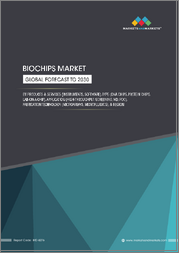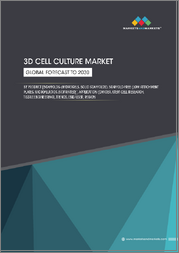
|
시장보고서
상품코드
1441377
세계의 마이크로플루이딕스 시장 : 규모 및 예측 - 용도별, 재료별, 기술별, 지역별 분석(2023-2030년)Global Microfluidics Market Size study & Forecast, by Application, by Material, by Technology and Regional Analysis, 2023-2030 |
||||||
세계의 마이크로플루이딕스(Microfluidics) 시장 규모는 2022년에 약 286억 5,000만 달러였으며, 예측기간 2023-2030년에 12.22% 이상의 안정적인 성장률로 성장할 것으로 예측되고 있습니다.
마이크로플루이딕스는 칩에 구축된 미세 채널을 통해 소량의 유체(보통 마이크로리터 또는 그 이하)를 조작하는 과학 및 기술입니다. 폭이 수십에서 수백 마이크로미터에 이르는 이러한 채널은 일반적인 거시적 유체 처리 기술에 비해 뚜렷한 이점을 제공합니다. 마이크로플루이딕스 장치는 흔히 마이크로플루이딕스 칩이라고 불립니다. 이러한 칩은 일반적으로 실리콘, 유리 또는 폴리머와 같은 재료로 만들어지며 복잡한 채널과 챔버로 구성된 네트워크를 포함합니다. 마이크로플루이딕스 시장은 연구 및 진단 분야에서 마이크로플루이딕스 장치의 사용 증가, 전 세계 COVID-19 확진자 수 증가로 인한 마이크로플루이딕스 장치 수요 증가, 약물 제형의 발전, 현장 진단에 대한 수요 증가 등의 요인으로 인해 확대되고 있습니다.
COVID-19 확진자가 급증하면서 많은 수의 샘플을 신속하고 효과적으로 검사할 수 있는 현장 진단에 대한 수요가 증가했습니다. 이는 이후 여러 마이크로플루이딕스 기술의 개발을 가속화하여 시장 성장에 영향을 미쳤습니다. 2022년 라이프 저널의 기사에 따르면, 마이크로플루이딕스 DA-D4(이중 항원 가교 면역 분석 기술, 모든 하위 클래스와 동형 항체를 포함한 총 항체를 검출하는 기술), 샌드위치/경쟁 면역 센서 기반 방법 등 다양한 기술이 SARS-CoV-2 항체를 검출하는 데 사용되며 기기당 3개의 샘플을 실행하면서 정확한 결과를 얻을 수 있는 방법도 있습니다. 또한 암, 당뇨병, 심혈관 질환 등과 같은 감염성 및 만성 질환의 유병률이 증가함에 따라 현장 진단에 대한 수요가 증가하여 예측 기간 동안 마이크로플루이딕스 시장에 대한 시장 기회가 창출 될 가능성이 높습니다. 예를 들어, IDF의 2022년 통계에 따르면 2021년 독일에서 약 610만 명이 당뇨병을 앓고 있으며, 2030년에는 650만 명으로 증가할 것으로 예상됩니다. 당뇨병 유병률이 증가함에 따라 마이크로플루이딕스 전기분사 기술을 통해 치료용 B 세포를 포함하는 새로운 다공성 마이크로캡슐의 개발이 필요합니다. 세계보건기구에 따르면 2021년 전 세계 성인 5억 3700만 명이 당뇨병에 걸렸으며, 10명 중 1명은 다른 당뇨병을 앓고 있습니다. 또한, 고령 인구와 비만 인구는 만성 질환에 걸릴 확률이 더 높습니다. 그러나 마이크로플루이딕스 기술을 기존 워크플로우에 통합해야 하는 점과 비싼 가격으로 인한 개발도상국의 낮은 수용도는 2023-2030년 예측 기간 동안 시장 성장을 저해할 것으로 예상됩니다.
마이크로플루이딕스 시장 조사에서 고려한 주요 지역은 아시아 태평양, 북미, 유럽, 남미, 중동 및 아프리카입니다. 북미는 지역의 잘 확립 된 의료 시스템, 현대 생물학적 치료법의 채택, 전염성 및 만성 질환의 빈도 증가와 같은 요인으로 인해 2022 년에 시장을 지배했습니다. 또한, 2021년 9월 기준 미국 제약협회(Pharmaceutical Research and Manufacturers of America) 데이터 업데이트에 따르면, PhRMA 회원사들은 새로운 치료법과 치료제를 찾기 위해 2021년 1023억 달러를 포함해 1조 1,000억 달러 이상을 투자한 것으로 나타났습니다. 아시아 태평양 지역은 정교한 과학 인프라의 발전, 경제 성장, 저렴한 노동력 등의 요인으로 인해 예측 기간 동안 크게 성장할 것으로 예상됩니다. 국제 기업들은 아직 개발되지 않은 아시아 태평양 마이크로플루이딕스 시장에 참여하기를 열망하고 있습니다. 외국 기업들이 미세유체 기반 진단 시장을 장악하고 있습니다. 또한, 이 지역의 저명한 기업들은 성능과 가격 측면에서 독특하고 매력적인 솔루션을 선보이며 시장 점유율을 높이고 있습니다.
본 연구의 목적은 최근 몇 년동안 다양한 부문와 국가 시장 규모를 밝히고 앞으로 수년간 시장 규모를 예측하는 것입니다. 이 보고서는 조사 대상 국가에서 산업의 질적 및 양적 측면을 모두 포함하도록 설계되었습니다.
또한 시장의 미래 성장을 규정하는 촉진 요인과 과제 등 중요한 측면에 대한 자세한 정보도 제공합니다. 또한 주요 기업의 경쟁 구도와 제품 제공에 대한 상세한 분석과 함께 이해관계자가 투자할 수 있는 거시적 시장의 잠재적인 기회도 포함하고 있습니다.
목차
제1장 주요 요약
제2장 세계의 마이크로플루이딕스 시장 정의 및 범위
- 조사 목적
- 시장 정의 및 범위
- 산업 진화
- 조사 범위
- 조사 대상년도
- 환율 변환율
제3장 마이크로플루이딕스 시장의 역학
- 마이크로플루이딕스 시장의 영향 분석(2020-2030년)
- 시장 성장 촉진 요인
- 연구·진단 분야에서 마이크로플루이딕스 디바이스 사용 증가
- 약제제제의 진보
- 시장의 과제
- 기존 워크플로우에 마이크로플루이딕스 기술을 통합하기 어려움
- 신흥국에서 수용 레벨의 낮음
- 시장 기회
- 만성 질환 증가
- 고령자와 고령화 인구 증가
- 시장 성장 촉진 요인
제4장 세계의 마이크로플루이딕스 시장 분석
- Porter's Five Forces 모델
- 공급기업의 협상력
- 구매자의 협상력
- 신규 참가업체의 위협
- 대체품의 위협
- 경쟁 기업간 경쟁 관계
- Porter's Five Forces의 영향 분석
- PEST 분석
- 정치
- 경제
- 사회
- 기술
- 환경
- 법률
- 주요 투자 기회
- 주요 성공 전략
- COVID-19의 영향 분석
- 파괴적 동향
- 업계 전문가의 시점
- 애널리스트의 결론 및 제안
제5장 마이크로플루이딕스 시장 : 용도별
- 시장 현황
- 마이크로플루이딕스 시장 : 용도별, 실적-잠재력 분석
- 마이크로플루이딕스 시장 : 용도별, 추정 및 예측(2020-2030년)
- 마이크로플루이딕스 시장 : 하위 부문 분석
- 의료/헬스케어
- 비의료
제6장 마이크로플루이딕스 시장 : 재료별
- 시장 현황
- 마이크로플루이딕스 시장 : 재료별, 실적-잠재력 분석
- 마이크로플루이딕스 시장 : 재료별, 추정 및 예측(2020-2030년)
- 마이크로플루이딕스 시장 : 하위 부문 분석
- 실리콘
- 유리
- 폴리머
- PDMS
- 기타
제7장 마이크로플루이딕스 시장 : 기술별
- 시장 현황
- 마이크로플루이딕스 시장 : 기술별, 실적-잠재력 분석
- 마이크로플루이딕스 시장 : 기술별, 추정 및 예측(2020-2030년)
- 마이크로플루이딕스 시장 : 하위 부문 분석
- 실험실 온칩
- 기관 온칩
- 연속 흐름 마이크로플루이딕스
- 옵토 유체와 마이크로플루이딕스
- 음향 유체와 마이크로플루이딕스
- 전기영동과 마이크로플루이딕스
제8장 마이크로플루이딕스 시장 : 지역별 분석
- 주요국
- 주요 신흥국
- 마이크로플루이딕스 시장 : 지역별 시장 현황
- 북미
- 미국
- 용도별 추정 및 예측(2020-2030년)
- 재료별 추정 및 예측(2020-2030년)
- 기술별 추정 및 예측(2020-2030년)
- 캐나다
- 미국
- 유럽
- 영국
- 독일
- 프랑스
- 스페인
- 이탈리아
- 기타 유럽
- 아시아 태평양
- 중국
- 인도
- 일본
- 호주
- 한국
- 기타 아시아 태평양
- 남미
- 브라질
- 멕시코
- 중동 및 아프리카
- 사우디아라비아
- 남아프리카공화국
- 기타 중동 및 아프리카
제9장 경쟁 정보
- 주요 기업의 SWOT 분석
- 주요 시장 전략
- 기업 개요
- F. Hoffmann-La Roche Ltd
- PerkinElmer, Inc.
- Agilent Technologies, Inc.
- Bio-Rad Laboratories, Inc.
- Danaher Corporation
- Emulate Inc.
- Illumina Inc.
- Ufluidix
- Fluigent SA
- ZEON Corporation
제10장 조사 과정
- 조사 과정
- 데이터 마이닝
- 분석
- 시장 추정
- 검증
- 출판
- 조사 속성
- 조사의 전제조건
Global Microfluidics Market is valued at approximately USD 28.65 billion in 2022 and is anticipated to grow with a healthy growth rate of more than 12.22% during the forecast period 2023-2030. Microfluidics is the science and technology of manipulating tiny amounts of fluids (usually microliters or even smaller ones) through microscopic channels built on chips. These channels, which range from tens to hundreds of micrometres wide, provide distinct advantages over typical macroscopic fluid handling technologies. Microfluidic devices are often called microfluidic chips. These chips are typically made of materials such as silicon, glass, or polymers and contain a network of intricate channels and chambers. The Microfluidics Market is expanding because of factors such as increasing use of microfluid devices in the field of research and diagnosis, the rise in the Global COVID-19 toll boosted the demand for microfluidic devices, advancements in drug formulations and higher demand for point-of-care diagnostics.
The high number of COVID-19 cases in the population has increased the demand for point-of-care diagnostics, which allow for the rapid and effective examination of large numbers of samples. This has subsequently accelerated the development of several microfluidic technologies, influencing market growth. According to an article by Life Journal in 2022, various techniques are used to detect SARS-CoV-2 antibodies, including the microfluidic DA-D4 (double-antigen bridging immunoassay technique, which detects total antibodies including all subclasses and isotypes) and sandwich/competitive immune-sensors-based methods that allow three samples to be run per device while providing accurate results. Furthermore, the increased prevalence of infectious and chronic diseases such as cancer, diabetes, cardiovascular disease, and others raises the demand for point-of-care diagnostics, which is likely to create market opportunities for the Microfluidics Market throughout the forecast period. For instance, according to the IDF's 2022 statistics, approximately 6.1 million individuals in Germany had diabetes in 2021, with the figure expected to rise to 6.5 million in 2030. The rising prevalence of diabetes necessitates the development of new porosity microcapsules that contain B cells for treatment via microfluidic electrospray technology. According to the World Health Organization, diabetes affected 537 million adults worldwide in 2021, with one in every ten developing other diabetes. Furthermore, older and obese populations are more likely to develop chronic diseases. However, the integration of microfluidics technology into existing workflows, as well as low acceptance in developing countries due to expensive prices, are projected to hinder market growth throughout the projection period 2023-2030.
The key regions considered for the Global Microfluidics Market study includes Asia Pacific, North America, Europe, Latin America, and Middle East & Africa. North America dominated the market in 2022 owing to factors such as the region's well-established healthcare system, adoption of modern biological therapies and increase in the frequency of infectious and chronic diseases. In addition, according to Pharmaceutical Research and Manufacturers of America data updates as of September 2021, PhRMA member businesses had invested more than USD 1.1 trillion in the quest for new treatments and cures, including USD 102.3 billion in 2021. Asia Pacific is expected to grow significantly over the forecast period, owing to factors such as the development of sophisticated scientific infrastructure, a growing economy, and affordable labor. International firms are eager to engage in the undeveloped APAC Microfluidics Market. Foreign businesses dominate the market for microfluidic-based diagnostics. Furthermore, prominent businesses in the region are presenting unique and fascinating solutions in terms of performance, and more importantly, pricing, that helped them to increase their market share.
Major market player included in this report are:
- F. Hoffmann-La Roche Ltd
- PerkinElmer, Inc.
- Agilent Technologies, Inc.
- Bio-Rad Laboratories, Inc.
- Danaher Corporation
- Emulate Inc.
- Illumina Inc.
- Ufluidix
- Fluigent SA
- ZEON Corporation
Recent Developments in the Market:
- In February 2023, Amar Equipment, an Indian startup, launched NanoMake, a microfluidics-based device. The goal was to enhance preclinical research for mRNA vaccines against COVID-19.
- In October 2022, Standard BioTools, Inc. introduced the X9 Real-time PCR system, a genomics instrument built on a microfluidics platform that provides great efficiency and data output in a single run. This introduction was supposed to expand the company's product offerings.
- In January 2022, uFluidix issued a call for industrial initiatives that require finance. The uFluidix team has increased its manufacturing capacity in the previous year and is currently optimizing for new process variables in thermoplastic microfluidic chips.
Global Microfluidics Market Report Scope:
- Historical Data - 2020 - 2021
- Base Year for Estimation - 2022
- Forecast period - 2023-2030
- Report Coverage - Revenue forecast, Company Ranking, Competitive Landscape, Growth factors, and Trends
- Segments Covered - Application, Material, Technology, Region
- Regional Scope - North America; Europe; Asia Pacific; Latin America; Middle East & Africa
- Customization Scope - Free report customization (equivalent up to 8 analyst's working hours) with purchase. Addition or alteration to country, regional & segment scope*
The objective of the study is to define market sizes of different segments & countries in recent years and to forecast the values to the coming years. The report is designed to incorporate both qualitative and quantitative aspects of the industry within countries involved in the study.
The report also caters detailed information about the crucial aspects such as driving factors & challenges which will define the future growth of the market. Additionally, it also incorporates potential opportunities in micro markets for stakeholders to invest along with the detailed analysis of competitive landscape and product offerings of key players. The detailed segments and sub-segment of the market are explained below:
By Application:
- Medical/Healthcare
- Non-medical
By Material:
- Silicon
- Glass
- Polymer
- PDMS
- Others
By Technology:
- Lab-on-a-chip
- Organs-on-chips
- Continuous Flow Microfluidics
- Optofluidics And Microfluidics
- Acoustofluidics And Microfluidics
- Electrophoresis And Microfluidics
By Region:
- North America
- U.S.
- Canada
- Europe
- UK
- Germany
- France
- Spain
- Italy
- ROE
- Asia Pacific
- China
- India
- Japan
- Australia
- South Korea
- RoAPAC
- Latin America
- Brazil
- Mexico
- Middle East & Africa
- Saudi Arabia
- South Africa
- Rest of Middle East & Africa
Table of Contents
Chapter 1. Executive Summary
- 1.1. Market Snapshot
- 1.2. Global & Segmental Market Estimates & Forecasts, 2020-2030 (USD Billion)
- 1.2.1. Microfluidics Market, by Region, 2020-2030 (USD Billion)
- 1.2.2. Microfluidics Market, by Application, 2020-2030 (USD Billion)
- 1.2.3. Microfluidics Market, by Material, 2020-2030 (USD Billion)
- 1.2.4. Microfluidics Market, by Technology, 2020-2030 (USD Billion)
- 1.3. Key Trends
- 1.4. Estimation Methodology
- 1.5. Research Assumption
Chapter 2. Global Microfluidics Market Definition and Scope
- 2.1. Objective of the Study
- 2.2. Market Definition & Scope
- 2.2.1. Industry Evolution
- 2.2.2. Scope of the Study
- 2.3. Years Considered for the Study
- 2.4. Currency Conversion Rates
Chapter 3. Global Microfluidics Market Dynamics
- 3.1. Microfluidics Market Impact Analysis (2020-2030)
- 3.1.1. Market Drivers
- 3.1.1.1. Increasing use of microfluid devices in field of research and diagnosis
- 3.1.1.2. Advancements in drug formulations
- 3.1.2. Market Challenges
- 3.1.2.1. Difficult Integration of microfluidics technology into existing workflows
- 3.1.2.2. Low level of acceptance in emerging countries
- 3.1.3. Market Opportunities
- 3.1.3.1. Rising prevalence of chronic diseases
- 3.1.3.2. Growing geriatric and aging population
- 3.1.1. Market Drivers
Chapter 4. Global Microfluidics Market Industry Analysis
- 4.1. Porter's 5 Force Model
- 4.1.1. Bargaining Power of Suppliers
- 4.1.2. Bargaining Power of Buyers
- 4.1.3. Threat of New Entrants
- 4.1.4. Threat of Substitutes
- 4.1.5. Competitive Rivalry
- 4.2. Porter's 5 Force Impact Analysis
- 4.3. PEST Analysis
- 4.3.1. Political
- 4.3.2. Economical
- 4.3.3. Social
- 4.3.4. Technological
- 4.3.5. Environmental
- 4.3.6. Legal
- 4.4. Top investment opportunity
- 4.5. Top winning strategies
- 4.6. COVID-19 Impact Analysis
- 4.7. Disruptive Trends
- 4.8. Industry Expert Perspective
- 4.9. Analyst Recommendation & Conclusion
Chapter 5. Global Microfluidics Market, by Application
- 5.1. Market Snapshot
- 5.2. Global Microfluidics Market by Application, Performance - Potential Analysis
- 5.3. Global Microfluidics Market Estimates & Forecasts by Application 2020-2030 (USD Billion)
- 5.4. Microfluidics Market, Sub Segment Analysis
- 5.4.1. Medical/Healthcare
- 5.4.2. Non-medical
Chapter 6. Global Microfluidics Market, by Material
- 6.1. Market Snapshot
- 6.2. Global Microfluidics Market by Material, Performance - Potential Analysis
- 6.3. Global Microfluidics Market Estimates & Forecasts by Material 2020-2030 (USD Billion)
- 6.4. Microfluidics Market, Sub Segment Analysis
- 6.4.1. Silicon
- 6.4.2. Glass
- 6.4.3. Polymer
- 6.4.4. PDMS
- 6.4.5. Others
Chapter 7. Global Microfluidics Market, by Technology
- 7.1. Market Snapshot
- 7.2. Global Microfluidics Market by Technology, Performance - Potential Analysis
- 7.3. Global Microfluidics Market Estimates & Forecasts by Technology 2020-2030 (USD Billion)
- 7.4. Microfluidics Market, Sub Segment Analysis
- 7.4.1. Lab-on-a-chip
- 7.4.2. Organs-on-chips
- 7.4.3. Continuous Flow Microfluidics
- 7.4.4. Optofluidics And Microfluidics
- 7.4.5. Acoustofluidics And Microfluidics
- 7.4.6. Electrophoresis And Microfluidics
Chapter 8. Global Microfluidics Market, Regional Analysis
- 8.1. Top Leading Countries
- 8.2. Top Emerging Countries
- 8.3. Microfluidics Market, Regional Market Snapshot
- 8.4. North America Microfluidics Market
- 8.4.1. U.S. Microfluidics Market
- 8.4.1.1. Application breakdown estimates & forecasts, 2020-2030
- 8.4.1.2. Material breakdown estimates & forecasts, 2020-2030
- 8.4.1.3. Technology breakdown estimates & forecasts, 2020-2030
- 8.4.2. Canada Microfluidics Market
- 8.4.1. U.S. Microfluidics Market
- 8.5. Europe Microfluidics Market Snapshot
- 8.5.1. U.K. Microfluidics Market
- 8.5.2. Germany Microfluidics Market
- 8.5.3. France Microfluidics Market
- 8.5.4. Spain Microfluidics Market
- 8.5.5. Italy Microfluidics Market
- 8.5.6. Rest of Europe Microfluidics Market
- 8.6. Asia-Pacific Microfluidics Market Snapshot
- 8.6.1. China Microfluidics Market
- 8.6.2. India Microfluidics Market
- 8.6.3. Japan Microfluidics Market
- 8.6.4. Australia Microfluidics Market
- 8.6.5. South Korea Microfluidics Market
- 8.6.6. Rest of Asia Pacific Microfluidics Market
- 8.7. Latin America Microfluidics Market Snapshot
- 8.7.1. Brazil Microfluidics Market
- 8.7.2. Mexico Microfluidics Market
- 8.8. Middle East & Africa Microfluidics Market
- 8.8.1. Saudi Arabia Microfluidics Market
- 8.8.2. South Africa Microfluidics Market
- 8.8.3. Rest of Middle East & Africa Microfluidics Market
Chapter 9. Competitive Intelligence
- 9.1. Key Company SWOT Analysis
- 9.1.1. Company 1
- 9.1.2. Company 2
- 9.1.3. Company 3
- 9.2. Top Market Strategies
- 9.3. Company Profiles
- 9.3.1. F. Hoffmann-La Roche Ltd
- 9.3.1.1. Key Information
- 9.3.1.2. Overview
- 9.3.1.3. Financial (Subject to Data Availability)
- 9.3.1.4. Product Summary
- 9.3.1.5. Recent Developments
- 9.3.2. PerkinElmer, Inc.
- 9.3.3. Agilent Technologies, Inc.
- 9.3.4. Bio-Rad Laboratories, Inc.
- 9.3.5. Danaher Corporation
- 9.3.6. Emulate Inc.
- 9.3.7. Illumina Inc.
- 9.3.8. Ufluidix
- 9.3.9. Fluigent SA
- 9.3.10. ZEON Corporation
- 9.3.1. F. Hoffmann-La Roche Ltd
Chapter 10. Research Process
- 10.1. Research Process
- 10.1.1. Data Mining
- 10.1.2. Analysis
- 10.1.3. Market Estimation
- 10.1.4. Validation
- 10.1.5. Publishing
- 10.2. Research Attributes
- 10.3. Research Assumption

















